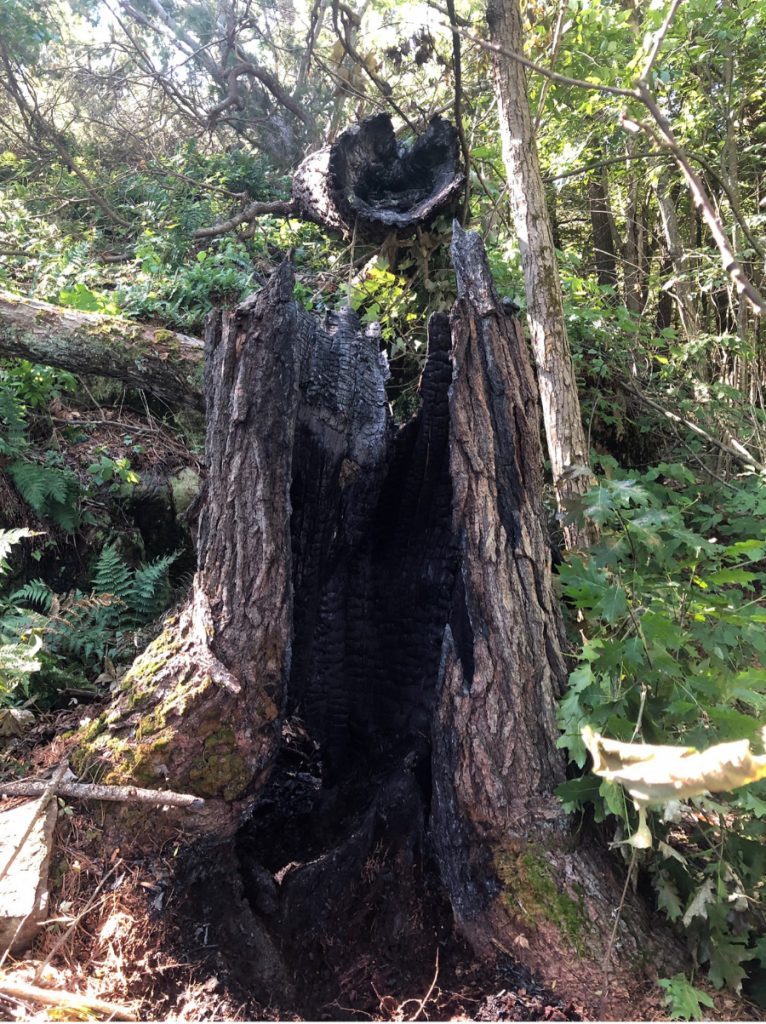
by Dave Sharpe, President, Pointe au Baril Islanders’ Association
The smell of smoke as the wind shifted to the north was the first thing to raise my concern. I initially thought that maybe someone was camping somewhere behind our cottage here on the eastern shore of Shawanaga Inlet and had lit a cooking fire.

I was alone at the cottage that morning in mid-July, so I took our dog in a kayak and we paddled around to our back bay where a river empties out through a wetland. Smoke was curling up through the high pines as I made my way along the shore.
Approaching the area through the marsh, I could see flames and smoke at ground level near the shore. As I got closer it became clear that a huge pine tree had been struck by lightning two nights earlier during a short but violent thunderstorm. Felled by the blast and cleaved in two lengthwise, this ancient tree had been smouldering and was now fiercely ablaze.
Yikes — the problem was bigger than I had anticipated.
Adrenaline fuelled my rapid paddle back to the cottage. After frantically pulling on work boots and grabbing a fire extinguisher and my cell phone, the dog and I fought our way through the thick bush toward the smoke.
I unloaded the full charge of the extinguisher into the burning stump and split hollow trunk, but it was immediately clear to me that we needed a lot more suppression to get this spreading fire under control, to prevent a full-on forest fire that would destroy our property and our cottage.
Thus began many hours of transport and setup to run our Honda fire pump with 300 feet of hose through the bush. More hose arrived after my wife returned to the cottage and arranged with a neighbour to bring the extra 40 feet of hose needed to get right on top of the fire as it spread.
Even once I had killed the fire on the surface, I still then shovelled down in the duff, exposed burning coals and smouldering peat. More digging and soaking continued until every hot spot was doused. I know that fires can linger and travel underground, often for a long time. Several return visits to the site over the next 48 hours verified the threat was truly extinguished. We were relieved and felt lucky to have survived this brush with disaster to our cottage and forest. But I made some mistakes, going back to before the fire even began.

* BNIA Note: we have adapted some of Dave Sharpe’s recommendations to our fire response program in Bayfield-Nares.
1. Be better prepared for fire than I was, with the numbers of verified emergency contacts and local helpers easily at hand, in one place on your cell phone. Emergency calls can be frustrating and chew up critical time. My 911 calls were transferred to fire reporting stations which in turn transferred to regional stations that never picked up after repeated efforts.
In Bayfield-Nares, we advise that you NOT call 911 for a fire emergency — it might feel right, but it’s just wasted time, as Dave Sharpe discovered. The best thing you can do, after immediately attempting to fight the fire yourself with extinguishers or buckets of water is to call your neighbours and the BNIA first responders for your area. See the inside back flap of the BNIA Directory “Prepare Now for a Fire Emergency” for more advice, or login to our website to update your fire pump status online and in the Directory.
2. Even if you don’t have a fire pump, have some simple means of immediately fighting a cottage or island fire. Stockpile some cheap plastic buckets in a prominent spot near the shore. Several Bayfield Inlet fires have been fought initially by bucket brigade. Buckets are low-tech but can be used immediately, before a pump can be located, transported, and set up. Plus, they can immediately put any family or neighbour volunteers to work.
3. Having a fire pump all gassed up, pre-tested and ready to start, and all the nozzles and hoses stored close at hand, saved our property. How long would it take you to get your equipment up and running? How many people know how to run your pump? Are there clear instructions nearby? Have you practiced recently?
4. Having our fire hoses “zig-zag folded” and laid flat in a portable storage bin was a lifesaver for us. We could move them, along with the pump, to the shoreline close to the fire and quickly run them through the bush without the hose snagging and twisting as it was deployed. This twisting often results from hoses stored in rolls and hurriedly deployed, costing precious time.
5. After a close thunderstorm, do a good check for lightning ignition all around your area. I was away from the cottage the night of the storm on July 11. My wife, was alone, saw a lightning flash, and the almost instantaneous thunderclap almost knocked her out of bed. Undoubtedly, that was the strike that destroyed the old pine and began the fire.
6. Never ignore signs of a fire, or figure someone else will look after it. If you smell smoke or see smoke, anywhere in your cottage area, act immediately. Go investigate. If a camper is having an outdoor fire, outside of evening hours or when the fire rating is High or Extreme, communicate the regulations to them, politely. (See page 19 of the 2022 BNIA Directory.)
7. Who would you call in the case of a fire? Do your research now and update it every year. Share the information with all your family and regular cottage users.
All’s well that ends well, but our fire was just a little too close for comfort. At the risk of stating the obvious, fire is that one threat that we, who live in an isolated community without emergency fire services, need to be vigilant about preventing. And with the weather patterns getting more violent, having firefighting equipment close at hand is more critical than ever.
8. We are our own first responders for fire emergencies, both individually and collectively.
9. If you suspect a forest fire in your area, call 705-564-6056. (Forest fires only, not for cottage or structure fires.)
10. Find more info about about BNIA Fire Education and Safety elsewhere on this website.